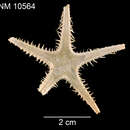Comprehensive Description
provided by Smithsonian Contributions to Zoology
Pectinaster gracilis Verrill
Pectinaster gracilis Verrill, 1915:145, pl. 6: fig. 1, pl. 14: fig. 4, pl. 15: figs. 1–1b.
This small species has slender, evenly tapered arms, and the regularly stellate form is depressed. The dorsal plates are hemispherical, not at all crowded or tessellate, and bear a tuft of small spinules. The plates are of all sizes, and some of the larger ones bear a small central spine. A few thickened and enlarged plates, raised slightly above the general disc surface, surround the 3–7 papular pores in each papularium. The superomarginals encroach less on the dorsal surface than in P. mixtus, and they are set at a less oblique angle on the arms. They are covered with small, rough spinules and each bears a central erect spine a little longer than the width of the plate. The inferomarginal plates are nearly square, alternate with the superomarginals, and bear one (interradially sometimes two) spine like that of the superomarginals. They are sparsely covered with small, rough spinules. The single series of rounded actinal interradial plates does not extend beyond the first pair of inferomarginals; they bear a few short spinules, not sharp. No pedicellariae were observed.
The projecting adambulacral plates bear a circlet of spines and spinules, a few small spinules on the actinal edge and 7 or 8 slender spines on the furrow edge. There is one (rarely two) large spine on the actinal face. The mouth plates are wide, short, and rounded. Each jaw half bears one large preoral spine and 6 or 7 long, slender, divergent lateral spines. The actinal surface bears several pairs of short, acute spines. The small, slightly sunken madreporite is very deeply channeled and touches or nearly touches the adjacent superomarginals.
Verrill reports this species as very common in the West Indies, in 70–300 fathoms.
MATERIAL EXAMINED.–Oregon station unknown (6) off the Florida Keys, 200 fathoms [R=13 mm, r=3 mm, Rr=1:4].
The mouth plates in this order are inconspicuous. The inferomarginal and superomarginal plates correspond with one another, and are without intermarginal channels. The tube feet are in two rows. Pedicellariae, when present, are valvate and sunken into the ossicles.
- bibliographic citation
- Downey, Maureen E. 1973. "Starfishes from the Caribbean and the Gulf of Mexico." Smithsonian Contributions to Zoology. 1-158. https://doi.org/10.5479/si.00810282.126

